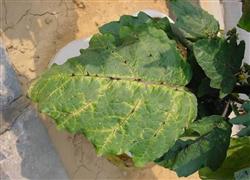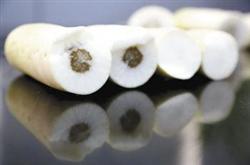What is the cause of eggplant falling flowers and fruits?

What is the cause of eggplant falling flowers and fruits? Is there any way to prevent eggplant from falling flowers and fruits? Also ask experienced friends to help guide in eggplant production, usually serious flower and fruit drop, restricting the improvement of output, the planting network sorted out the reasons and prevention and control methods of eggplant flower and fruit drop, listed below for netizens' reference. The causes of eggplant falling flowers and fruits: 1. The temperature is not suitable for the higher temperature in the fruiting period, the optimum temperature in the fruiting period is between 25 ℃ and 30 ℃, the night temperature should be between 15 ℃ and 20 ℃, the temperature is lower than 15 ℃ or higher than 35 mol, the growth is slow, the flower drop is serious, and the fruit is less in early and summer. Reason 2, if the flower development of eggplant is good, the flower shape is large, the color is dense, the style is longer or equal when flowering, which is beneficial to pollination and fertilization, and the fruit setting is good, while if the flower is not well developed, the style is shorter than the anther, it is difficult to get pollination and most of them fall out. Reason 3, lack of nutrition, lack of fertilizer and less water, the plant growth is weak, nutrients are used to maintain growth, the reproductive ability is low, fruit setting is less. Reason 4, topdressing is not timely, inappropriate time, but also not conducive to fruit setting is generally shown as early topdressing, overgrown plants, resulting in flower and fruit shedding. If topdressing is not in time, the production capacity of premature senescence of plants will be reduced, which is also disadvantageous to fruit setting. Reason 5. If the value plant grows excessively or weakens due to the improper proportion of fertilization, the proportion of plant vegetative growth and reproductive growth is out of balance and it is difficult to set fruit. Reason 6, poor light, low photosynthetic capacity, poor quality of flowers, easy to fall off; eggplant is a light-loving crop, which requires strict light time. When the light is weak, the plant growth and development slows down and the flower bud quality is poor. Reason 7. The damage of diseases and insect pests led to the decrease of plant photosynthetic capacity, which was not conducive to the accumulation of photosynthates, but also to flower and fruit setting. The main diseases and insect pests harmful to eggplant are Verticillium wilt, aphids, red spiders and so on. Verticillium wilt generally did not occur at the seedling stage, but mostly from the bottom to the top or from one side to the whole plant in the fruit setting stage, the leaf turned yellow at the edge of the leaf and between the veins, and then developed to the half leaf or the whole leaf yellowed, the photosynthetic fertility decreased, the nutrient accumulation decreased and the fruit setting rate decreased. Aphids are harmful to many clusters and suck the host juice with needle tube haustors, resulting in yellowing, atrophy, deformation and withering of the leaves. Both adult mites and nymphs of red spiders can feed on plant sap, which can change color or dry up the leaves, resulting in the decrease of photosynthetic capacity of leaves, which is disadvantageous to fruit setting. Prevention and control measures of eggplant falling flowers and fruits: first, pay attention to promoting the growth of stigmas and reducing the proportion of short flowers, so as to improve the rate of fruit setting. The key measure applied in the production is to strengthen the temperature management in the flowering and fruiting stage. Within the temperature range of the fruiting period, the temperature is slightly lower, about 25 ℃ in the daytime and between 15 ℃ and 20 ℃ at night, which slows the flower bud differentiation and facilitates the formation of long stigmas, which can effectively control the proportion of short stigmas. In addition, the planting stubble should be arranged reasonably so that the temperature during the fruiting period is above 25 ℃ in the daytime and between 15 ℃ and 20 ℃ at night. In the summer high temperature period, attention should be paid to watering and cooling. In case of continuous high temperature weather, shading net can be used to build a shade shed to reduce the temperature and increase the fruit setting rate. Method 2. Strengthen fertilizer and water management and keep the plant growing moderately, so as to balance the relationship between vegetative growth and reproductive growth, so as to improve the fruit setting rate: especially, the first topdressing should be timely, preferably when the diameter of the first layer of fruit is 3 cm, and the appropriate period of topdressing should be used to prevent early fertilization, which will lead to the shedding of flowers and fruits. After that, each fruit should be picked and fertilized once, so as to carry out nutritional supplement, prevent the plant from premature senescence and reduce the production capacity. In addition, attention should be paid to the appropriate proportion of fertilization to prevent the imbalance between vegetative growth and reproductive growth caused by partial fertilizer, especially to prevent the partial application of nitrogen fertilizer, which leads to the phenomenon of overgrowth of plants. The suitable ratio of nitrogen, phosphorus and potassium in eggplant production is 2 ∶ 1 ∶ 1.7. attention should be paid to observe plant growth in production, and methods of promoting weak and controlling strength should be adopted to balance plant growth. Method 3. Strengthen plant shape adjustment to ensure good plant permeability in order to facilitate fruit setting: in production, attention should be paid to timely removal of old branches and leaves, as eggplant generally produces flowers and fruits at bifurcations, so attention should be paid to promoting growth and bifurcation in production. generally, the first, second and third bifurcations are mostly effective flowers, which can develop and set fruit very well, but after four branches, the flower bud differentiation is poor, the fruit setting rate is low, and most of them are ineffective flowers. Therefore, attention should be paid to the bifurcation after the removal of the four branches in the production, so as to control the number of branches in the field and concentrate the supply of nutrients to facilitate fruit setting. Method 4. Strengthen the prevention and control of diseases and insect pests: in production, the control of Verticillium wilt, red spiders and aphids should be strengthened. Before sowing, soak the seeds with 0.2% carbendazim wettable powder for 1 hour or soak the seeds in 55 ℃ warm water for 15 minutes. Soil disinfection was carried out by sprinkling carbendazim per mu in the planting field, and the roots were irrigated with 50% mixed sulfur suspension and 50% carbendazim wettable powder 500 times in the early stage of Verticillium wilt, each plant irrigated with 500 ml. After the occurrence of red spiders, spray 1.8% 2000 times of agricultural acaroid EC or 2.5% Uranus 3000 times to control. At the initial stage of aphid occurrence, 50% aldicarb wettable powder was sprayed with 2000000 times or 21% methamphetamine 3000 times or 10% imidacloprid 3000 times. For the plants damaged by diseases and insect pests, foliar spraying of Yemanbao, phytoxin, 0.5% urea + 0.5% potassium dihydrogen phosphate should be carried out in time to fertilize the leaves, supplement nutrition, improve the photosynthetic capacity of leaves, increase the accumulation of photosynthates, and improve the fruit setting rate. Method 5. Spray chemicals to protect flowers and fruits. Two days before flowering, coat calyx or fruit stalk with 2.4 Mel D (30ml / kg); spray 120mg / kg or 180ml / kg, 200ml / kg sodium bisulfite on the first layer fruit after fruit setting, which can effectively increase material accumulation and fruit setting rate. Click to get more eggplant planting techniques click to get more vegetable planting techniques
- Prev

What is the lack of magnesium in eggplant?
What is the lack of magnesium in eggplant? Is there any way to prevent it? There are no netizens to help introduce the symptoms and prevention methods of magnesium deficiency in eggplant, which are listed below for netizens' reference. Symptoms of magnesium deficiency in eggplant: magnesium deficiency in eggplant is generally caused by chlorosis and yellowing of the lower leaves, and the veins remain green.
- Next

What is radish "black heart"?
What is radish "black heart"? Radish black heart is caused by what? Is there any way to prevent and cure it? Also ask netizens to help guide the introduction of radish black rot, commonly known as black heart, rotten heart, the disease is a disease caused by bacteria, planting network sorted out the harm and causes of radish black rot and control methods, the following.
Related
- Where is it suitable to grow horseradish in China? it is expected to see the middle altitude horseradish in Alishan.
- How to prevent tomato virus disease reasonably? (Control methods included)
- Many people like to plant towel gourd on the balcony. What are the main points of this method and management?
- What crops can chili peppers be mixed with?
- Fertilization techniques and matters needing attention in Tomato
- What are the grafting techniques for peach seedlings in spring?
- Harm and control methods of root swelling disease of Chinese cabbage
- What are the pests of sweet potatoes? How to prevent and cure it?
- Symptoms, causes and Control methods of navel Rot in Tomato
- The cause of "Cucumber rotten bibcock" in Farmers' planting Cucumber and its Control Plan

